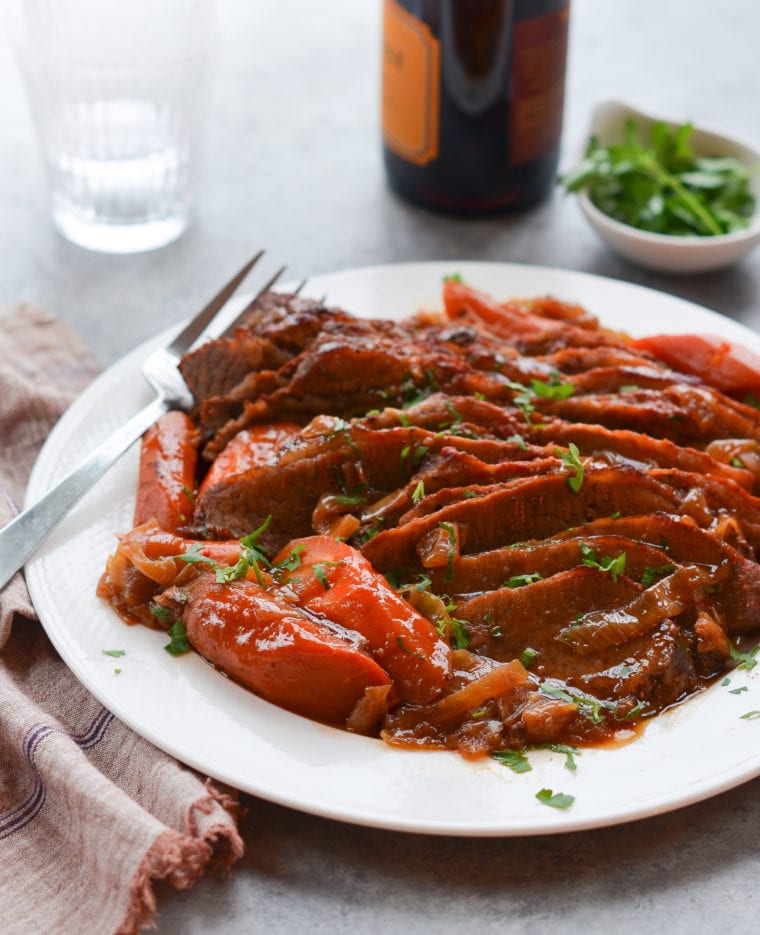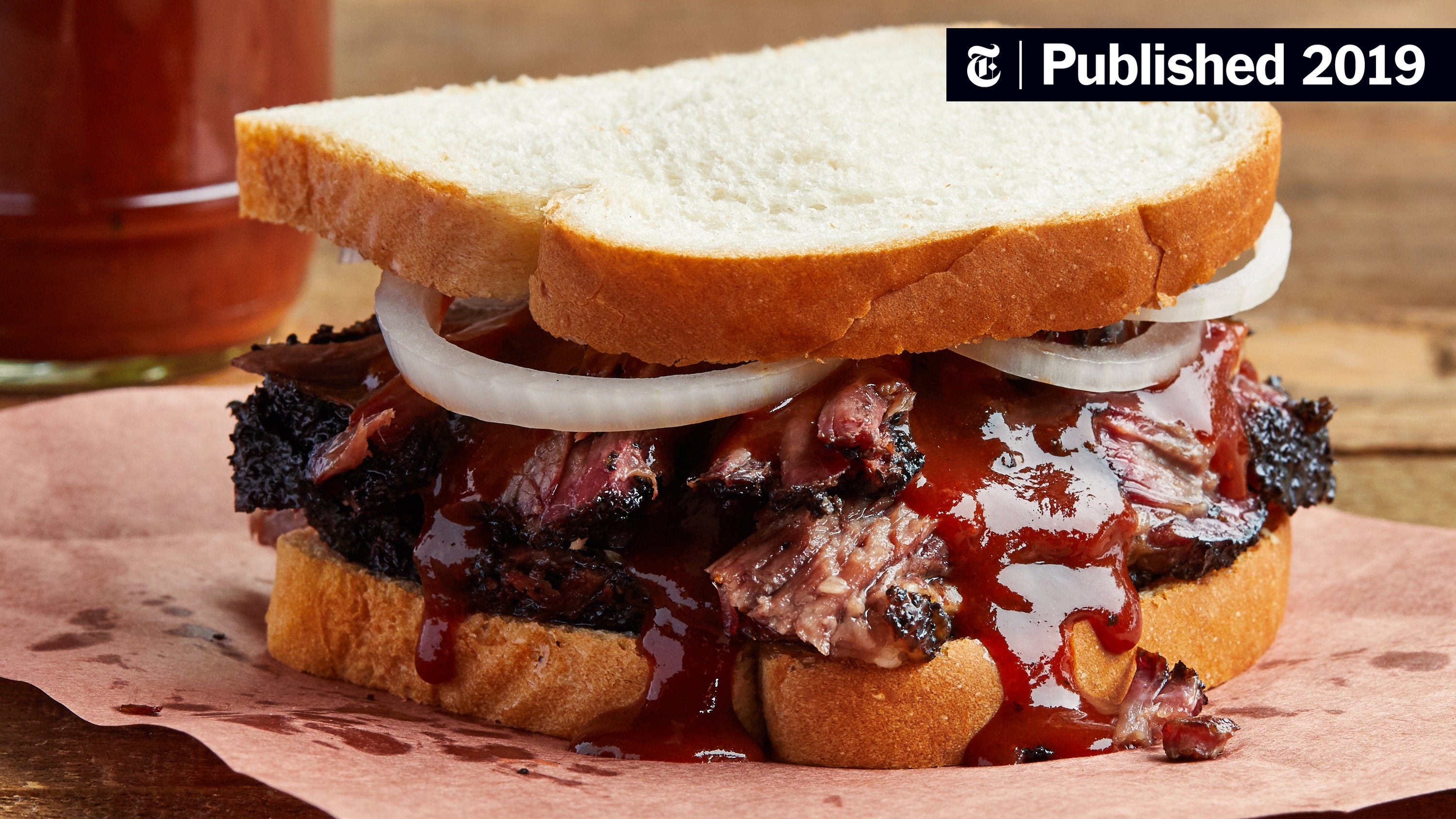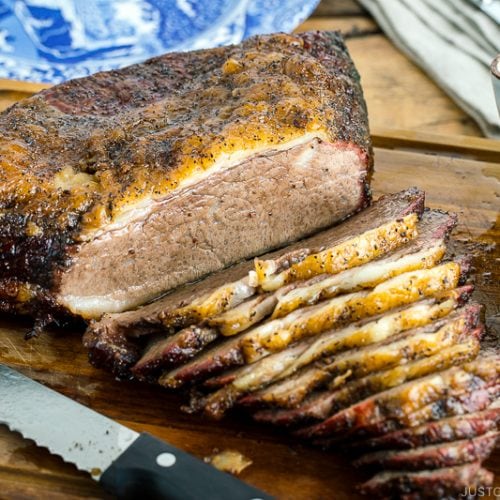
Introduction
Background Information On The Confusion Surrounding Brisket And Its Meat Type
There has been some confusion surrounding the meat type of brisket. Traditionally, brisket comes from beef, but as BBQ culture evolves, pork brisket has also emerged as an option. Brisket is known for its tough texture and abundance of connective tissue, which makes it ideal for slow cooking over low heat.
Why It’s Important To Clarify Whether Brisket Is Beef Or Pork
Clarifying whether brisket is beef or pork is important for various reasons. For those with dietary restrictions or preferences, knowing the meat type can help them make informed choices. Additionally, it aids in understanding the flavor profiles and cooking techniques associated with each type of brisket. Whether one prefers the rich and robust flavors of beef or the slightly sweeter taste of pork, having clarity on the meat type enables cooks to experiment and create delicious dishes accordingly.
Here is a comparison table to further highlight the distinctions between beef brisket and pork brisket:
| Beef Brisket | Pork Brisket |
|---|---|
| Comes from cattle | Comes from pigs |
| Rich and robust flavor | Slightly sweeter taste |
| More popular | Emerging option |
| Longer cooking time required | Shorter cooking time required |
| Commonly smoked or braised | Commonly smoked or slow-cooked |
| Often served sliced or shredded | Often served shredded or pulled |
Both beef and pork brisket offer unique and delicious options for those looking to explore different cuts of meat. While beef brisket is more popular and has a richer, stronger flavor, pork brisket can be equally tantalizing with its subtly sweet taste. Regardless of whether brisket is pork or beef, mastering the art of low and slow cooking methods is essential to achieve tender and flavorful results. So, whether you choose beef brisket or pork brisket, take your time, apply the right techniques, and enjoy the deliciousness that awaits.
What Is Brisket?
Definition And Explanation Of Brisket As A Cut Of Meat
Brisket is a meat cut that is derived from the lower chest or breast of a cow. It is a versatile piece of meat that is known for its rich flavor and tender texture. Brisket is commonly used in barbecue and slow-cooked dishes due to its abundance of connective tissue, which breaks down during the cooking process, resulting in a tender and juicy end product.
A Brief Overview Of Its Characteristics And Popular Uses In Cooking
Brisket has distinct characteristics that make it popular among meat lovers. Its rich flavor is often described as bold and robust, while its texture is tender and moist. Brisket can be prepared in various ways, including boiling, braising, or roasting. However, it is most commonly associated with smoking or slow cooking over low heat for an extended period of time.
The popularity of brisket spans across different culinary traditions, but it is particularly connected to Texan cuisine, where it is often showcased as a star ingredient. In Texas, brisket is traditionally smoked with the help of wood fire, resulting in a distinct smoky flavor that enhances its taste.
In terms of usage, brisket is commonly served in sandwiches, stews, and as a main dish alongside sides such as coleslaw and cornbread. It is also a popular choice for competitions and gatherings, where pitmasters and home cooks alike showcase their skills in producing a perfectly cooked brisket.
Regardless of whether it is beef or pork brisket, mastering the art of low and slow cooking methods is essential to achieve tender and flavorful results. Brisket offers a delightful dining experience, and its versatility allows for endless culinary creations. Whether you prefer the rich and robust flavors of beef or the slightly sweeter taste of pork, there is a brisket variation to suit every palate. So, fire up that smoker or slow cooker, take your time, and savor the deliciousness that awaits.
Brisket: A Beef Cut
Explanation That Brisket Is Always Beef, Never Pork
Brisket is a cut of meat that is derived from the lower chest or breast of a cow, making it a beef cut. Traditionally, brisket has always been associated with beef and is considered a staple in many cuisines around the world. While there may be variations and adaptations in different culinary traditions, the primary source of brisket is beef.
Detailed Description Of Its Origin And Location In The Cow’s Body
Located below the shoulder and above the foreshank, brisket is positioned in the front area of the cow’s body. It consists of the pectoral muscles, which are well-worked and highly textured due to the cow’s constant movements. As a result, brisket contains a significant amount of connective tissue and collagen, which contribute to its tenderness.
Brisket is renowned for its rich flavor and distinctive texture. Due to the specific marbling and composition of muscles in this part of the cow, brisket is known for its bold and robust taste. It is often described as having a deep, savory flavor that intensifies when cooked slowly.
Due to its connective tissue, brisket requires slow cooking methods to break down the collagen and tenderize the meat. This is why it is commonly associated with barbecue and slow-cooked dishes, where it is cooked over low heat for an extended period of time. Whether smoked, braised, or roasted, the slow cooking process transforms the tough texture of brisket into a tender and juicy delicacy.
While pork can also be used to make brisket in certain culinary contexts, it is important to note that traditionally and predominantly, brisket is sourced from beef. Whether you prefer the robust flavors of beef or the slightly sweeter taste of pork, brisket offers an array of culinary possibilities. So, next time you fire up your smoker or slow cooker, remember to choose your preferred meat and savor the deliciousness that a well-cooked brisket brings.

The Pectoral Muscles And Tough Texture
The Role Of The Pectoral Muscles In Giving Brisket Its Tough And Fibrous Texture
Brisket, whether it’s beef or pork, comes from the pectoral muscles of the animal. These muscles are located in the front area of the cow or pig’s body and are responsible for supporting movement and weight-bearing. Due to the constant use and activity of these muscles, they develop a lot of collagen, which contributes to the tough and fibrous texture of brisket.
Why The Collagen In Brisket Needs To Break Down For Tenderness
Collagen is a type of tough protein that forms the connective tissue in meat. In the case of brisket, the high collagen content is what gives it its initial toughness. However, when cooked properly, the prolonged exposure to heat breaks down the collagen into gelatin, resulting in a tender and moist texture. This process is necessary to transform the tough collagen into a more palatable form.
When it comes to taste and texture, both beef brisket and pork brisket have their own merits. Beef brisket is known for its bold and robust flavor, while pork brisket has a slightly sweeter taste. The primary difference lies in the source of the meat, with beef being the traditional and predominant choice for brisket.
Whether you choose beef or pork brisket, the slow cooking methods required to break down the collagen and tenderize the meat remain the same. Whether you smoke, braise, or roast your brisket, the low and slow cooking technique allows the collagen to break down, resulting in a tender and juicy final product.
So, whether you’re a fan of the rich flavors of beef or prefer the slightly sweeter taste of pork, both beef and pork brisket offer a range of culinary possibilities. Whichever meat you choose, make sure to appreciate the time and effort it takes to transform tough brisket into a delicious and melt-in-your-mouth delicacy.
Low And Slow Cooking Tradition
Explanation Of The Traditional Cooking Method For Brisket
Both beef and pork brisket are traditionally cooked using a low and slow method. This involves cooking the meat slowly over low heat for an extended period of time. This technique ensures that the tough connective tissue in the brisket breaks down, resulting in a tender and flavorful end product.
Whether you choose to smoke, braise, or roast your brisket, the key is to maintain a low temperature and cook the meat slowly. This allows the collagen in the brisket to break down gradually and transform into gelatin, which gives the meat its melt-in-your-mouth texture.
The Science Behind How Collagen Breaks Down Into Gelatin During Slow Cooking
Collagen is a tough protein that forms the connective tissue in meat. In the case of brisket, the high collagen content is what contributes to its initial toughness. However, when subjected to low heat over many hours, the collagen in the brisket undergoes a process called hydrolysis.
During hydrolysis, the collagen molecules break down into smaller, more soluble molecules, including gelatin. This transformation leads to the tenderization of the meat, as the gelatin helps to hold moisture and creates a rich and succulent texture.
The prolonged and slow cooking process allows enough time for the collagen to fully break down into gelatin, resulting in a tender and juicy brisket. It is this process that gives brisket its distinct texture and makes it a popular choice for barbecue enthusiasts.
In conclusion, whether you choose beef or pork brisket, the low and slow cooking method remains the same. Both types of brisket benefit from the slow breakdown of collagen, resulting in tender and flavorful meat. So whether you prefer the bold flavor of beef or the slightly sweeter taste of pork, both options offer a range of culinary possibilities. Whichever meat you choose, take the time to appreciate the traditional cooking method that transforms tough brisket into a delicious and mouthwatering delicacy.
The Rich Flavor Of Brisket
Discussion Of The Distinctive Flavor Profile That Brisket Offers
The flavor of brisket, whether beef or pork, is renowned for its unique and delicious taste. Brisket is prized for its juicy and tender texture, but it is the rich flavor that truly sets it apart.
Beef brisket is known for its deep, beefy flavor. When cooked properly, it boasts a robust and savory taste that is often associated with traditional barbecue. The marbling of fat in beef brisket enhances the flavor, as it melts during cooking and adds a richness that permeates the meat.
Pork brisket, on the other hand, offers a slightly different flavor profile. Due to its higher fat content compared to beef, pork brisket delivers a richer and sweeter taste. The fat renders during cooking, infusing the meat with a luscious and indulgent flavor. This sweetness pairs well with various seasonings and marinades, allowing for endless possibilities when it comes to culinary preparations.
How Its Richness Enhances Various Culinary Preparations
The richness of brisket makes it a versatile protein that can be prepared in numerous ways, each resulting in a delicious and satisfying dish. Here are a few examples of how the flavor profile of brisket enhances different culinary preparations:
- Slow-smoked brisket: Whether beef or pork, smoking brisket at low temperatures for an extended period of time allows the flavor to develop and intensify. The wood smoke imparts a smoky undertone that complements the richness of the meat, creating a mouthwatering barbecue experience.
- Braised brisket: Braising involves cooking the brisket in a flavorful liquid over low heat. The slow cooking method allows the flavors to meld together, resulting in a tender and succulent dish. The richness of the brisket enhances the sauce or gravy used in the braising process, creating a harmonious combination of flavors.
- Grilled brisket: Grilling brisket over high heat imparts a delightful charred flavor to the meat. The richness of the beef or pork adds an extra layer of depth to the overall taste, making it a favorite choice for summertime barbecues and cookouts.
In conclusion, the rich flavor of brisket, whether beef or pork, elevates any dish it is used in. The deep and savory taste of beef brisket and the sweeter, more indulgent flavor of pork brisket provide endless possibilities for culinary exploration. Regardless of your preference, brisket offers a unique experience that is sure to satisfy any barbecue enthusiast or culinary connoisseur.
Brisket As A Gourmet Delight
Highlighting The Popularity Of Brisket In Gourmet And Fine Dining Cuisines
Brisket has become a gourmet delight, with its rich flavor and tender texture earning it a prominent place in gourmet and fine dining cuisines. Chefs and food enthusiasts alike appreciate the unique taste and versatility of this cut of meat, using it in a variety of dishes to create unforgettable dining experiences.
Examples Of Dishes And Cuisines Where Brisket Takes Center Stage
Brisket is a versatile protein that can be prepared in numerous ways, each resulting in a delicious and satisfying dish. Here are a few examples of how brisket shines in gourmet and fine dining cuisines:
- Beef Brisket Bourguignon: In this classic French dish, beef brisket is slow-cooked in red wine with aromatic vegetables and herbs. The result is a luxurious and indulgent stew, with the rich flavor of the brisket complementing the deep flavors of the wine and vegetables.
- Asian-style Braised Brisket: In Asian cuisines such as Chinese and Korean, brisket is often braised in a flavorful combination of soy sauce, ginger, garlic, and spices. The slow cooking process tenderizes the meat and infuses it with the bold flavors of the marinade, creating a dish that is both succulent and aromatic.
- Smoked Brisket Ravioli: In Italian cuisine, smoked brisket is used as a filling for homemade ravioli. The smoky and savory flavor of the brisket adds a unique twist to this classic pasta dish, elevating it to a gourmet level.
These examples demonstrate how brisket can be the star ingredient in gourmet and fine dining cuisines. Its rich flavor and tender texture make it a beloved choice among chefs and food enthusiasts, who enjoy exploring the endless possibilities of culinary creations using this versatile cut of meat.

Cooking Tips And Techniques For Brisket
Guidelines For Cooking Brisket To Perfection
When it comes to cooking brisket, following a few guidelines can ensure you achieve a tender and flavorful result:
- Choose the right cut: Whether you opt for fresh beef brisket or corned beef brisket, make sure to purchase the cut called for in your recipe.
- Look for quality meat: When shopping for brisket, choose a piece that has good color and appears moist but not wet. This indicates freshness and tenderness.
- Trim excess fat: Brisket often has a layer of fat on one side. Trimming this excess fat can help prevent the meat from becoming greasy and can promote even cooking.
- Season generously: Rubbing your brisket with a flavorful dry rub or marinade will enhance its taste and tenderness. Be sure to season all sides of the meat thoroughly.
- Allow time for marinating: If using a marinade, give the brisket enough time to absorb the flavors. Ideally, marinate it overnight in the fridge for maximum taste infusion.
Recommended Cooking Methods, Seasoning, And Temperature Control
The following cooking methods and techniques are highly recommended for achieving a perfect brisket:
- Low and slow: Brisket is a tough cut of meat that benefits from long, slow cooking. Opt for methods such as smoking, braising, or slow roasting to achieve a tender result.
- Use indirect heat: To avoid drying out the brisket, cook it using indirect heat. This allows for even cooking and prevents excessive charring or burning.
- Maintain a consistent temperature: Keeping a steady temperature throughout the cooking process is crucial. Use a reliable meat thermometer to monitor the internal temperature of the brisket and adjust the heat accordingly.
- Consider wrapping or tenting: Some cooks prefer to wrap their brisket in foil or a butcher paper during the cooking process. This method helps retain moisture and can result in a more tender final product.
- Allow for resting time: Once the brisket is cooked, resist the urge to immediately slice into it. Letting it rest for at least 15-20 minutes allows the juices to redistribute, resulting in a moister and more flavorful brisket.
By following these cooking tips and techniques, you can achieve a perfectly cooked brisket every time, with tender and flavorful meat that will impress your guests and make for a memorable dining experience.
Cooking Tips And Techniques For Brisket
Guidelines For Cooking Brisket To Perfection
When cooking brisket, it is important to follow a few guidelines to ensure a tender and flavorful result:
- Choose the right cut: Whether using fresh beef brisket or corned beef brisket, make sure to purchase the appropriate cut for your recipe.
- Look for quality meat: When shopping for brisket, select a piece that has good color and appears moist but not wet. This indicates freshness and tenderness.
- Trim excess fat: Brisket often has a layer of fat on one side. Trimming this excess fat can help prevent the meat from becoming greasy and promote even cooking.
- Season generously: Rub your brisket with a flavorful dry rub or marinade to enhance its taste and tenderness. Be sure to season all sides of the meat thoroughly.
- Allow time for marinating: If using a marinade, give the brisket enough time to absorb the flavors. Ideally, marinate it overnight in the refrigerator for maximum taste infusion.
Recommended Cooking Methods, Seasoning, And Temperature Control
The following cooking methods and techniques are highly recommended for achieving a perfect brisket:
- Low and slow cooking: Brisket is a tough cut of meat that benefits from long, slow cooking. Opt for methods such as smoking, braising, or slow roasting to achieve a tender result.
- Use indirect heat: To prevent the brisket from drying out, cook it using indirect heat. This allows for even cooking and prevents excessive charring or burning.
- Maintain a consistent temperature: Maintaining a steady temperature throughout the cooking process is crucial. Use a reliable meat thermometer to monitor the internal temperature of the brisket and adjust the heat accordingly.
- Consider wrapping or tenting: Some cooks prefer to wrap their brisket in foil or butcher paper during the cooking process. This method helps retain moisture and can result in a more tender final product.
- Allow for resting time: Once the brisket is cooked, resist the urge to immediately slice into it. Let it rest for at least 15-20 minutes to allow the juices to redistribute, resulting in a moister and more flavorful brisket.
Following these cooking tips and techniques will help you achieve a perfectly cooked brisket every time, with tender and flavorful meat that will impress your guests and create a memorable dining experience.
Reiteration That Brisket Is A Cut Of Beef, Not Pork
It is important to note that brisket is a cut of beef and not pork. While beef brisket is more commonly used, pork brisket can also be a tasty alternative. However, it is necessary to adjust the cooking time and temperature due to the smaller size of pork brisket.
Final Thoughts On The Versatility And Appeal Of Brisket In Various Culinary Traditions
Both beef and pork brisket offer unique and delicious options for those looking to explore different cuts of meat. Brisket, when cooked properly using low and slow methods, delivers incredibly moist and tender meat infused with smoky richness.
Whether you prefer the classic beef version or are eager to try pork brisket, mastering the art of low and slow cooking methods is essential to achieve tender and flavorful results. Brisket remains a favorite among barbecue aficionados and is a versatile ingredient that can be incorporated into various culinary traditions.
Frequently Asked Questions about Brisket Meat
Q: Is brisket beef or pork?
A: Brisket is a cut of meat that is traditionally associated with beef. It is commonly used in dishes such as smoked barbecue, roast beef, and corned beef. However, it’s important to note that there are also pork briskets available in some regions or cuisines.
Q: What is brisket?
A: Brisket is a flavorful and tender cut of meat that comes from the breast or lower chest of the animal. It consists of two main muscles, the point and the flat, which are separated by a layer of fat. Brisket is known for its rich marbling, which contributes to its juicy and melt-in-your-mouth texture when cooked properly.
Q: How do you cook beef brisket?
A: Beef brisket can be cooked in several ways, including smoking, braising, or oven roasting. One popular method is slow smoking, which involves seasoning the meat with a dry rub and cooking it over low heat for several hours. This allows the meat to become tender and infused with smoky flavors. Braising is another common method, where the brisket is cooked in liquid, such as broth or wine, at a low temperature for an extended period of time.
Q: Can you use pork brisket instead of beef?
A: While beef brisket is the most commonly used type, pork brisket is also available. Pork brisket has a slightly different flavor profile compared to beef, but it can still be delicious when cooked properly. It is often used in regional cuisines, such as southern-style barbecues or Asian cooking. However, if a recipe specifically calls for beef brisket, it’s best to stick with that unless you are adventurous and willing to experiment.
Q: Are there any differences between beef and pork brisket?
A: Yes, there are some differences between beef brisket and pork brisket. Beef brisket tends to have more marbling, which leads to a richer and more intense flavor. Pork brisket, on the other hand, has a milder flavor and can be slightly sweeter. Additionally, pork brisket usually requires a shorter cooking time compared to beef brisket due to its lower fat content.
Q: Can you mix beef and pork brisket together?
A: Mixing beef and pork brisket together is not a common practice, as the flavors and textures of the two meats differ. However, in some creative culinary applications, such as fusion cuisine or experimental cooking, combining the two types of brisket might yield intriguing results. It’s all about personal preferences and experimenting with different flavor combinations.
In Summary
Brisket is primarily associated with beef, but pork brisket is also available in certain regions or cuisines. Beef brisket is more commonly used, known for its marbling and rich flavor, while pork brisket has a milder taste. Each type requires specific cooking methods and can be used in various dishes depending on personal preferences. Feel free to explore and experiment to find your favorite type of brisket!

Keep up with weekly specials through Facebook under “The Grill at Great Bridge.”